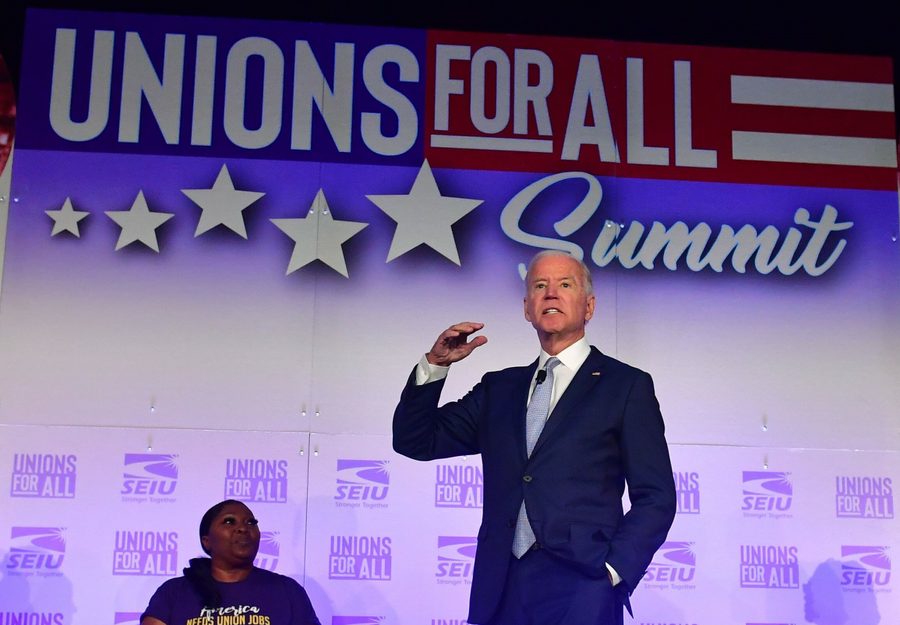Time For Unions to Give the Democratic Party an Ultimatum
Money spent on organizing is always well spent. You can’t say the same about political donations.
Hamilton Nolan

Yesterday, on Labor Day, Joe Biden did an online event with AFL-CIO president Richard Trumka to talk up unions. At this point in his political career, Biden can do these things in his sleep. His well rehearsed grab bag of pro-union lines (”My uncle in Scranton, Uncle Ed, used to say, ‘Joe, you’re labor from belt buckle to shoe sole’”) flow out easily. The question for America’s union members is whether anything tangible will flow back to us if Biden is elected, or if we will — as has happened in previous Democratic administrations — have to satisfy ourselves with pats on the head and White House photo-ops.
Though the share of union voters that vote Democratic fluctuates, the financial support that major unions offer to the Democratic Party does not. In 2016, labor unions in total spent well over $100 million backing Hillary Clinton, including $15 million from the AFL-CIO (to super PACs) and close to $20 million each from the National Education Association and the SEIU. This election, the spending is even more intense. The SEIU alone has pledged to spend $150 million to elect the Democratic candidate.
All of the money that unions spend on presidential candidates comes from the pockets of working people. It is precious. A hedge fund manager would certainly not make a nine-figure investment without the knowledge that he would earn a good return; neither should janitors and nurses. For unions, every dollar that is donated to politicians is a dollar that is not spent on organizing new union members. And a dollar spent on organizing new union members is always a good investment — particularly when the share of Americans who are union members has fallen to one in ten, and is still falling. New organizing is an existential issue for unions: They will either turn around their long membership decline, or they will slowly die. So it is important that political spending by unions always be considered in context. Before every donation, we should ask, “Is this a better use of this money than hiring more union organizers, to give more working people the protection of a union?”
Let us pause here to acknowledge the obvious: The Republican Party wants to eradicate unions from existence, and the Democrats do not. It will always be in the interest of labor unions to see to it that Republicans do not have control of lawmaking, from the local to the national level. One of the biggest barriers to new union organizing are anti-union labor laws and hostile government enforcement agencies, and changing those things is part of reviving unions. I do not propose that unions give up on political influence. I propose instead that unions be smarter about spending their members’ money in a way that grows and expands that influence in the long term.
Writing checks to the DNC is not the only way of exerting political influence. In fact, it is a bad way. Your influence lasts only for the current election cycle, and its continuance is premised on continued donations, and furthermore, if your candidate loses, you get nothing. It is vital that not only unions but also the Democratic Party itself recognize that growing union membership is a direct benefit to Democratic political goals, apart from any political donations. Strong unions on their own can help achieve economic equality, racial equality, workplace safety, and other things that are part of the Democratic platform. They are the only tool that allows working people to build power on their own, without having to ask for that power to be apportioned by elected officials.
And let’s talk about political power and elections. A strong union is an army for a chosen political candidate. Union members can phone bank and knock on doors and wave signs and do everything that a political donation can do, besides buying infinite attack ads. Good unions are powerful not just because they can raise funds, but because they can mobilize a platoon of highly motivated people to pursue political actions. The labor movement’s modern tilt towards political spending and away from organizing, as embodied by the AFL-CIO’s budgetary choices, have been a failed experiment. Union density continues to fall, Republicans are in control, and even when Democrats did have power, political gains for unions were almost nonexistent.
Many in the labor movement are still bitter about the failure of Barack Obama to pass the Employee Free Choice Act — which would have made union organizing easier, and which was labor’s top legislative priority — between 2008 and 2010, when the Democrats had both Congress and the White House. Despite heavy spending to get Obama elected, unions were not ultimately a top priority. We do not have to repeat this debacle again.
This time around, the bill most desired by organized labor is the PRO Act, a set of labor reforms that would amount to the most progressive change in labor law in more than a half century. (The PRO Act would be far more meaningful than what Obama failed to pass). Biden, and the rest of the Democrats, have sworn to pass it if given the chance. Fine. Since unions are already fully invested in 2020, they should make a simple bargain: If the PRO Act is not signed into law by the 2022 midterms, they will not donate any money to the Democratic candidate in 2024. Rather, they will accept that donations have not achieved the desired results, and spend that money instead on union organizing.
This does not mean ceding power to Republicans. Republicans have won their current power as unions have donated hundreds of millions of dollars to Democrats! The results of this experiment are in! Organized labor should stop being the “dumb money” in the political investing game. Checks written to directly support presidential candidates are a bet that may offer a paltry payout, or result in a total loss. But money spent on organizing is always well spent. It gives more working people the protection of a union. It can directly achieve the sort of material gains that Democrats promise to legislate secondhand. It builds a union army that can itself be deployed in place of political donations. And, most crucially, maximizing the number of people who get to experience union campaigns themselves is one of the only real tools for spreading class consciousness and actually changing the nature of the electorate itself, to move towards a nation in which a candidate like Bernie Sanders might one day be able to win a majority of votes.
New union organizing is an investment in personal power, political power, the present, and the future. It is inherently an investment in not just the Democratic Party, but in the power to create a better Democratic Party. Had unions spent their money over the past several presidential election cycles on organizing rather than on political donations, we would have hundreds of thousands more union members than we have today — and we would not have any fewer national legislative achievements. That would be impossible.
Hamilton Nolan is a labor writer for In These Times. He has spent the past decade writing about labor and politics for Gawker, Splinter, The Guardian, and elsewhere. More of his work is on Substack.








